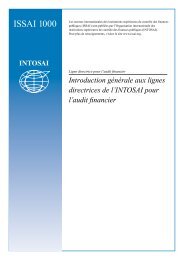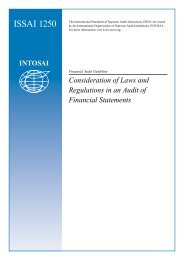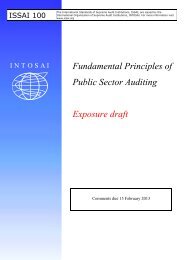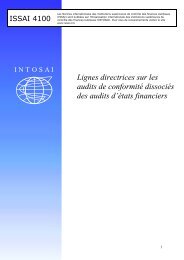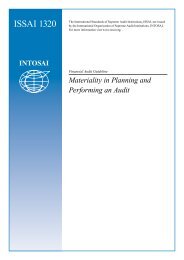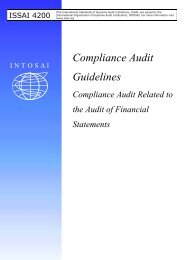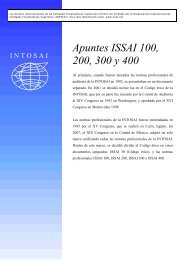ISSAI 1240
ISSAI 1240
ISSAI 1240
Create successful ePaper yourself
Turn your PDF publications into a flip-book with our unique Google optimized e-Paper software.
<strong>ISSAI</strong> <strong>1240</strong><br />
practice note 240<br />
Appendix 1: Examples of Additional Fraud Risk Factors in<br />
the Public Sector Environment<br />
The fraud risk factors identified in this appendix are examples of such factors that may be faced by public<br />
sector auditors. Although the risk factors cover a broad range of situations, they are only examples<br />
and, accordingly, public sector auditors may identify additional or different risk factors. Not all of these<br />
examples are relevant in all circumstances, and some may be of greater or lesser significance in public<br />
sector entities of different sizes or with different characteristics or circumstances. Also, the order of the<br />
examples of risk factors provided is not intended to reflect their relative importance or frequency of occurrence.<br />
Risk Factors Relating to Misstatements Arising from<br />
Fraudulent Financial Reporting<br />
Risk factors that relate to misstatements arising from fraudulent financial reporting are classified according<br />
to the three conditions generally present when fraud exists: incentives/pressures, opportunities, and<br />
attitudes/rationalization. The following are examples of risk factors relating to misstatements arising<br />
from fraudulent financial reporting.<br />
Incentives/Pressures<br />
Financial instability or threats by political, economic, budget, or entity operating conditions, such as (or<br />
as indicated by):<br />
• Weak budgetary controls;<br />
• Privatizations;<br />
• New programs;<br />
• Major changes to existing programs;<br />
• New financing sources;<br />
• New legislation and regulations or directives;<br />
• Political decisions such as relocation of operations;<br />
• Programs without sufficient allocated resources and funding;<br />
• Procurement of goods and services in certain industries such as defense;<br />
• Outsourcing of government activities;<br />
• Operations subject to special investigations;<br />
• Changes in political leadership;<br />
• Public and private partnerships.<br />
Excessive pressure exists for management to meet the requirements or expectations of third parties or<br />
those charged with governance due to the following:<br />
• Increased public expectations;<br />
• Higher than normal expectations to meet budget;<br />
• Reduction in budgets without corresponding reduction in service delivery expectations.<br />
The Auditor’s Responsibilities Relating to Fraud in an Audit of Financial Statements 227



